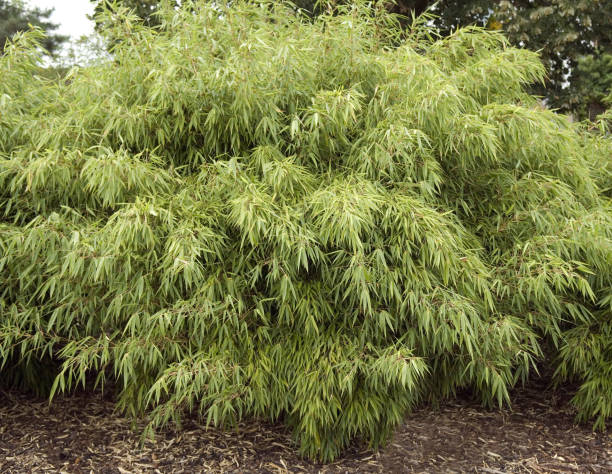Bamboos are vigorous and dramatic plants with a touch of the exotic. The swaying canes add structure and movement to the garden. They can be grown as living screens and focal points.
There are various stem colours, foliage types and heights to choose from, spreading or forming clumps, large and small.

Bamboos will tolerate most soil types but prefer moist and free draining soil. They do not like waterlogged or extremely dry conditions.
Most bamboos are vigorous plants, and some can grow large and spread rapidly, so make sure you have enough space for the variety you choose. Smaller types are ideal as ground cover and for planting in large containers.
There are two main types of bamboos:
Clump formers produce dense clumps and are less invasive, Fargesia is the most common form.
Running bamboos produce long underground stems that will spread if allowed. These include various forms of Phyllostachys, though they may stay as a clump in poor or dry soil.
Planting
Bamboos should be planted in the spring so they can establish roots and new canes before the plant becomes dormant in the autumn. Bamboos drop leaves during the winter and spring, this is normal, and they will regrow in spring.
Dig a planting hole about twice the width of the rootball, and 2-3cm deeper. Place in the hole and fill in with a mix of soil and compost level with soil surface. Firm in and water well. Mulch the soil surface to hold in moisture.
Keep well-watered for at least a year after planting.
If the bamboo needs to be contained within an area it is easiest to do this at planting. Dig a trench at least 60cm deep, with plenty of room to spread. Line the sides with a solid barrier, such as paving slabs or bamboo control system. Do not leave any gaps and ensure that the barrier protrudes at least 7cm above the soil surface. This can be hidden with mulch or stones.
Clumps can be kept under control with weedkiller. Cut around the base with a sharp spade to sever the underground roots and use a weedkiller such as Roundup Tough Weedkiller on the area to be removed.
Smaller bamboos grow well in pots. Choose a large container, at least 45cm wide and deep. Use John Innes No 3 compost with the addition of slow-release fertilizer pellets and water-retaining gel. Soak the pot after planting and keep watered.
Watering
Bamboos growing in the ground need to be watered regularly during dry spells, particularly in the year after planting. Plants in containers dry out quickly, particularly if they are in a windy situation, so water them regularly. This may be once a day during the summer. Containers will also need watering during the winter.
Lack of water can cause poor growth, leaf drop, and die-back.
Feeding Bamboos benefit from feeding for luxuriant foliage. Use a nitrogen rich fertilizer early in the year, followed by a balanced fertilizer through to August.
For containers apply a general liquid feed such as liquid Growmore from March to October.
Pruning and training
To show off the attractive canes, remove some of the lower foliage, cutting as close to the main cane as possible. This looks particularly effective on container grown specimens.
Remove any weak, dead, damaged, or spindly canes in spring, cutting them to ground level. If the clump has become too dense and congested, allow air and light in by cutting out some canes to the base.
You can also prune the tops of the canes to contain their height. This also encourages the cane to produce more lush foliage.
Bamboo Varieties
available now
Fargesia
Well behaved clump forming bamboos
Fargesia murieliae
Umbrella Bamboo
An elegant, evergreen, clump-forming bamboo with graceful, arching yellow-green canes 2.5-3.5m high or more. Bright green leaves up to 10cm in length.
Fargesia nitida
Chinese Fountain Bamboo
An elegant bamboo forming a compact clump of erect to arching, purple-flushed green canes to 4m high, with slender dark green leaves 9cm in length.
Fargesia robusta
Clumps of deep blue-green canes which turn paler as they mature. Up to 4m High. Leaves are green on top and blue-green underneath. Creamy white-brown flowers appear in the summer.
Pingwu has variegated, checkered canes that are non-invasive and ideal for creating a narrow screen because of its tight growth habits. Up to 5m high.
Fargesia rufa
An evergreen, clump-forming bamboo which is upright when young and moderately arching when mature. It grows to a maximum height of 3 metres and spread of 1.5 metres. New canes emerge bright green.
Semiarundinaria yashadake kimmei
A vigorous, bushy, clump-forming bamboo, growing to 3m or more, with green oblong leaves up to 25cm long. The densely packed canes are yellow with a green stripe and may be flushed red if in a sunny position.



